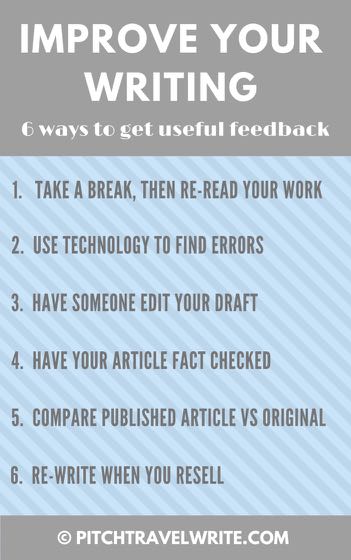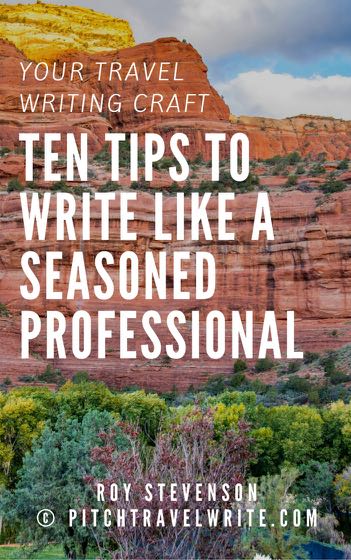- Home
- Travel Writing Craft Resources
- Improve Your Writing
Improve Your Writing:
Six Ways to Get Useful Feedback
By Roy Stevenson
Trying to improve your writing as a freelancer can be difficult in such a solitary occupation. Like many of the creative arts, one of the biggest challenges you face is getting useful feedback.
Unless you're in a writer’s group that meets regularly to critique each others work, you simply type and pray. When editors buy your work that’s one positive sign that your words are up to snuff.
But can you ever be satisfied with the status quo? Do you sometimes wonder how you can improve your writing?
No one starts out with fine prose. When I look back at articles from my first couple of years, I cringe at the clumsiness of some of my writing. But we all have to start somewhere, and we don’t start at the finish line.
So, how can you improve your writing?
Here are six
techniques that I’ve used to improve my stories. I think you’ll find
these techniques easy to implement and very useful for improving your
writing over time.
1. Take a Break, then Re-Read Your Work
When writing an article you want to be very focused. But you can only be in the “writing zone” for so long before your mind
wanders and you become unproductive. That’s when it’s time to take a
break. Have a drink of water, take a walk, do a few stretches. Then,
revisit your story with a fresh mind.
When you sit down again, begin by reading your
article from the start. You'll find yourself tidying it up as
you re-read it – correcting grammar errors, improving sentences, and so
on.
If the words just aren’t flowing, re-read the article from
the start again. Look at it from a flow perspective. Pretend you are
reading the article for the first time. Does the order make sense?
Does it catch your interest? Do the thoughts in one paragraph flow into
the next one? What’s missing? What can you do to improve your
writing?
And after you finish your first draft, take a break for a day or two before you do the final edits. You'll come back to your work with a clear head and fresh mind, ready to make whatever improvements are needed.
2. Use Technology to Improve Your Writing
Most software includes tools to improve your writing on the spot. Besides helping with grammar and spelling while writing the article, some word processing software will offer quite a bit more information if you set up your preferences correctly.
After I’ve completed and rewritten the article to my satisfaction, I’ll run the “Spelling and Grammar” check in MS-Word. It’s a good check for a few things you might have missed.
There's one important thing to remember about Spellcheck: it will correct your spelling, but that doesn't mean the word is used in the correct context. Spellcheck doesn’t know the difference between a deer and a dear, for example. So you and your volunteer editor will need to keep an eye out for these things.
If you set up the options in MS-Word , once it does a spelling and grammar check a more detailed summary will pop up. This includes detailed information about the number of words in the document, words per paragraph, sentences per paragraph, readability and a few other statistics.
I wrote a separate article about using readability statistics and how it can further improve your writing.
One other way to improve your writing is to invest in a few books to help you with style, structure and general writing advice. Here are my favorite books to help you.
3. Have Someone Edit Your Draft
My wife, who also edits this website, has been editing my
articles for years. She reads through a print copy of my article and
makes notations in red. I have rarely disagreed with her feedback.
Notice
that I say she reads a print copy of my stories. There’s something
about reading from the printed page that enables us to find typos,
grammar errors, and readability issues much easier than on a computer. It's because we "scan" on computers and "read" the printed page. Errors jump out at us far better from the printed page than
from the computer screen.
After my wife/editor has read my
story, she reviews the document with me. She looks for all the usual
things: poor grammar, typos, misspellings, repeated words, repetitive
ideas.
More importantly, she reads my work for “flow” and
“readability”. A story with good readability, or flow, leads you gently
by the hand from paragraph to paragraph. A flowing story has no abrupt
topic changes and leads you logically to the next point with some kind of transition.
Find
someone you know and trust to read your work before you submit it to the
editor. Another writer would be a good choice. Be sure to explain to your volunteer editor what you’re hoping
to achieve – and that you need their best feedback to improve your
writing.
My wife can sometimes be brutal with her recommended
changes – but it always helps me improve my writing. And the magazine
editor has a lot less work to do in the end. That makes for a happy
editor.
4. Have Your Article Fact Checked
It’s good practice to send your final draft on to the tourist agency
representative/media director for fact checking before you submit the
story to the editor. The media rep may not be critiquing your style,
but I have found them sometimes correcting typos and misspellings.
If the story has been fact checked, you gain brownie points with the editor when you submit the story. It's less work for the editor.
I
always mention that my stories have been fact-checked by the media
director. Editors always appreciate when you take care of this step for them.
5. Compare Published Article vs Original
When you receive a magazine with your article in it, bring up the original manuscript on your computer and compare it, sentence by sentence, with the published article.
Note how the editor changed the title. Pay attention to sub-titles and headings that changed or were added. Look at how the editor changed your sentences, re-arranged paragraphs, deleted words, added words and otherwise improved your writing.
These changes make the story more “readable”. This is great feedback from a professional editor – and it’s free!
Some writers are offended when an editor changes their words. But editors know their audience best of all. So take note of their changes and use that knowledge to give them a better article the next time around.
6. Re-write When You Resell
Reselling your articles helps you make more money from each word you write. I resell a high percentage of my articles and recommend that you try
doing this, too. When I resell them I always rewrite them.
When you're rewriting an old article you're revisiting it with a fresh mind. You’ll find all sorts of ways to improve and smooth out the
piece.
You'll also get the chance to correct any mistakes and incorporate new things you've learned. We all make recurring mistakes – and you’ll be able to eliminate them from the new version of the story.
Break into Travel Writing
with the Creative Pack
The Creative Pack includes 3 eBooks that are the starting point for every travel writer: dreaming up unique story ideas that you can sell, finding the best writing niches for you based on your interests, passions and experience, and the art & craft of travel writing. They’re the pieces of the puzzle that come before you ever write a query letter to sell your articles to magazine editors.
If you're just getting started in travel writing, this group of resources will help you improve your craft, generate story ideas that sell, and develop your own unique and meaningful niche.
These eBooks can be purchased separately, but when you buy the bundle you'll save more than 10% off individual prices! Learn more here ...
Related articles that will interest you:

Roy Stevenson is a professional travel writer and the author of www.PitchTravelWrite.com. Over the past ten years, he’s had more than 1000 articles published in 200 magazines, trade and specialty journals, in-flights, on-boards, blogs and websites and has traveled on assignment around the U.S. and to dozens of international destinations.
IF YOU ENJOYED THIS POST, GET UPDATES. IT'S FREE.


















